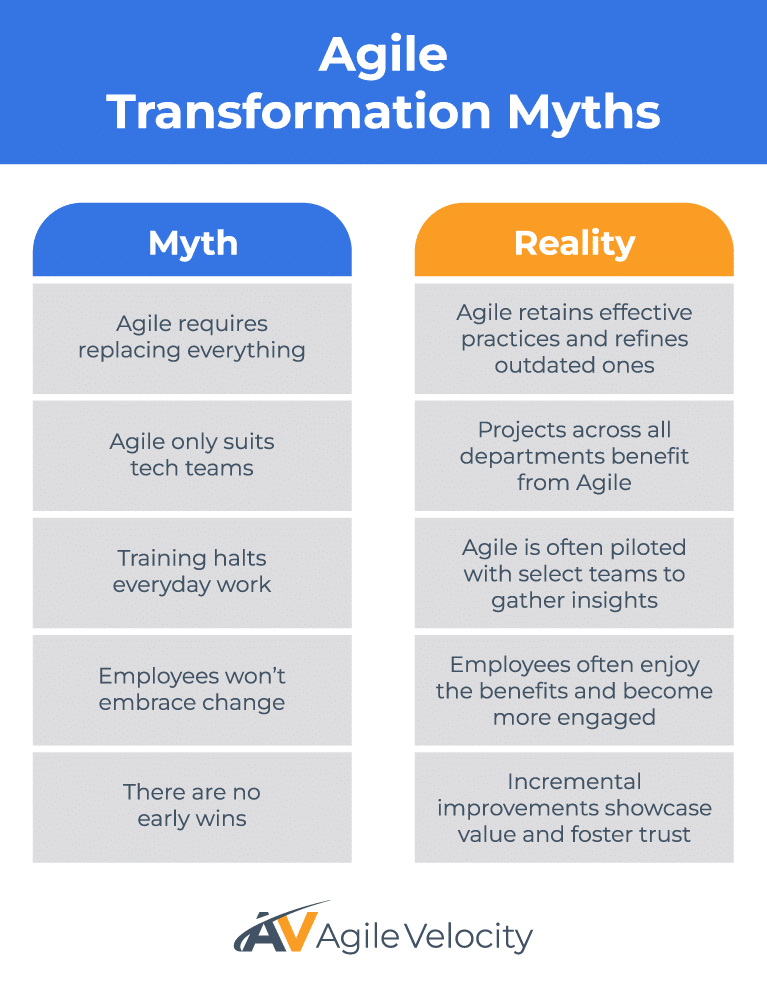In today’s business landscape, leaders face increasing pressure to achieve profitability, improve operational efficiency, and stay competitive. One proven way to stay ahead is by embracing business agility—leveraging Agile methodologies, Lean principles, and adaptive leadership to drive efficiency and profitability. By moving beyond outdated processes, organizations can cultivate a culture of flexibility, faster value delivery, and sustainable growth.
We’ll examine how agility addresses the limitations of traditional ways of working, focusing on benefits such as improved cross-functional alignment and iterative learning. We’ll also show how tools like Path to Agility® Navigator capture current capabilities, identify challenges, and guide measurable progress. Plus, we’ll explore how leadership engagement and cultural change propel these transformations.
If your goal is to thrive in today’s marketplace by fostering adaptability, enhancing efficiency, and delivering greater value to stakeholders, read on.
What is Business Agility?
Business agility transforms how organizations think, adapt, and operate—enabling them to respond quickly to shifting customer demands, market conditions, and disruptions. Rather than relying on rigid structures, agility promotes cross-department collaboration, iterative planning, and continuous improvement.
Agility applies to finance, sales, marketing, operations—every part of the enterprise. By embedding adaptability at all levels, organizations build resilience and speed, outperforming counterparts locked into long approval chains or static annual plans.
For instance, many technology-driven businesses have shortened product timelines by adopting Agile cycles across development teams. Finance groups adopting iterative forecasting methods, such as Agile forecasting, often experience improvements in accuracy and adaptability, potentially resulting in fewer errors and more reliable numerical insights. These outcomes underline how agility enhances day-to-day execution, allowing companies to pivot faster than those relying solely on sequential, siloed processes.
Problems with Traditional Methods and Their Impact on Business Outcomes
Traditional methods can struggle in a fast-evolving market. Rigid workflows and siloed departments often appear efficient when conditions remain stable but break down once customer needs or industry conditions shift.
A common pitfall is slow value delivery. Lengthy project timelines mean a product might reach customers after their preferences have changed, hampering revenue and market positioning. Prolonged planning cycles also create blind spots, making it easy to miss emerging trends or new demands.
Siloed teams produce inefficiencies, duplicating work or veering away from higher-level goals. This drains resources that could otherwise fuel innovation. Additionally, cumbersome processes frustrate employees, causing disengagement and raising turnover costs. By moving to adaptive, collaborative ways of working, organizations free themselves from these traps—focusing more on delivering results that align with evolving business objectives.
Avoid Unnecessary Setbacks
Core Benefits of Adopting Agile Methodologies
Adopting Agile Methodologies transforms how organizations respond to market changes and customer demands, leading to significant competitive advantages. Agile practices facilitate faster decision-making, enabling teams to adapt quickly to new insights or environmental shifts. This approach enhances cross-functional collaboration and breaks down silos, resulting in more cohesive and efficient operations. Moreover, Agile fosters a culture of continuous improvement, where feedback loops ensure iterative progress and learning. By embracing Agile, organizations also see improved employee engagement, as teams experience greater ownership and autonomy over their work, leading to increased job satisfaction and productivity.
Embracing Agile Methodologies unlocks a range of organizational benefits such as:
- Increased Operational Efficiency – Agile uses smaller, iterative cycles that limit rework and reduce bottlenecks. Predictable costs and stable delivery replace the scramble of last-minute emergencies.
- Stronger Team Alignment – Frequent Daily Scrum sessions encourage open discussion, highlight shared priorities, and foster a supportive team culture.
- Accelerated Time-to-Market – Agile teams rapidly deliver core product features, generating revenue sooner while validating if they’re meeting customer needs.
- Built-in Continuous Improvement – After each iteration, teams review progress and identify ways to refine workflows. This habit of learning helps teams adapt and fosters a culture that remains responsive.
- Delivering Tangible Value to Stakeholders – Agile emphasizes early collaboration with customers. By validating features sooner, products and services better reflect real-world usage and preferences.
Organizations that adopt these principles often see quicker release cycles, better decision-making, and more effective cross-functional collaboration. Ultimately, these improvements enhance performance and profitability.
Strategic Organizational Changes for Successful Agile Transformation
Popular frameworks can align projects to strategic goals in a flexible yet structured manner. That said, no single framework alone ensures true agility. Cultural shifts and leadership support are equally essential. Durable success hinges on broader strategic changes in leadership, collaboration, and culture.
Leadership Commitment: The Foundation for Change
Leaders who champion transparency and iterative thinking shape a supportive environment for agility. When they communicate openly, empower initiative, and encourage experiments, teams gain the confidence to embrace new practices.
Breaking Down Silos: Fostering Cross-Department Collaboration
Siloed structures bog down processes. By forming cross-functional teams, organizations drive shared understanding of goals, reduce redundant tasks, and shorten feedback loops.
Empowering Teams with Ownership and Flexibility
Empowered teams take responsibility for outcomes, reducing back-and-forth approvals. Scrum Masters and Product Owners clarify roles so that each contributor can focus on high-impact work.
Cultural Shifts to Support Agility at Scale
Since agility relies on open communication and feedback, it thrives in a culture that values learning and iteration. Embracing continuous improvement fuels ongoing adaptation.
Leveraging Structured Support
Especially in large enterprises, it’s easy for transformations to stall. Expert coaches and the clarity provided by Path to Agility Navigator ensure efforts remain consistent and aligned across departments.
How Business Agility Directly Impacts the Bottom Line

Business agility plays a critical role in shaping a company’s financial health by enabling swift responses to market changes and customer needs. By adopting agile practices, organizations not only gain the ability to rapidly deliver high-quality products but also reduce operational inefficiencies and costs. This flexibility helps to streamline processes, ensuring that resources are allocated efficiently and productively.
Companies that embrace agility can capitalize on market opportunities faster, leading to increased revenue streams and a stronger competitive edge. Ultimately, the continuous improvement loop intrinsic to business agility fosters innovation and drives sustainable growth, positively impacting the bottom line.
Shifting to business agility drives tangible financial gains like:
- Maximizing Profitability by Streamlining Operations – Agile helps identify and eliminate outdated tasks, enabling greater reinvestment in high-value activities that propel growth.
- Improving Resource Allocation to Enhance ROI – Through approaches like Lean Portfolio Management, leaders invest in the most impactful initiatives. The reduced waste directly translates to higher returns.
- Delivering Greater Customer Value Faster – Early and frequent releases strengthen customer loyalty by proving value more quickly.
- Boosting Employee Engagement and Retention – A clear mission, autonomy, and mutual accountability often lead to higher employee satisfaction and retention.. This people-centric focus increases employee retention and reduces turnover costs.
Key Steps to Embark on an Agile Transformation to Improve Operations
Transforming into a more agile business requires deliberate and strategic steps to foster agility across all facets of an organization. Starting with a clear vision for agility, organizations need to align this vision with their strategic goals while obtaining buy-in from leadership and stakeholders.
Establishing cross-functional teams and investing in training ensures that every team member is equipped with the necessary skills and mindset for adaptive work approaches. Continuous feedback and iteration become integral parts of operations, driving ongoing improvement.
As each of these steps unfolds, measuring progress with data ensures that adjustments can be made in real time to enhance the overall agility and effectiveness of the transformation.
- Assess Your Current State – Identify your existing processes and leadership styles. Path to Agility Navigator helps pinpoint gaps and create a transformation roadmap.
- Define Clear, Actionable Goals – Align objectives with specific results—shorter release cycles, higher quality, or enhanced collaboration—to guide your transformation.
- Choose the Right Tools and Frameworks – Determine whether Scrum, SAFe®, or Kanban suits your context. Path to Agility Navigator highlights where to focus your energy.
- Invest in Agile Training – Agile Training workshops equip individuals and teams with the mindset and techniques crucial for success.
- Engage Experienced Agile Coaches – Coaches provide tailored guidance, help manage cultural shifts, and address challenges before they hamper progress.
- Pilot and Scale Over Time – Start small to gather feedback and refine your approach. Then replicate effective practices throughout the organization.
- Foster a Culture of Adaptation and Ownership – Encourage employees to experiment, share lessons, and propose process tweaks that improve outcomes.
- Track Progress and Adjust as Needed – Use metrics and regular events to monitor progress. Refine policies and objectives to maintain momentum.
Is Your Organization Truly Ready?
How Agile Velocity Empowers Organizations Through Business Agility
Agile Velocity delivers results-focused Agile Transformations tailored to each organization’s strategic needs. Rather than forcing a rigid formula, the focus remains on genuine business metrics, from faster product delivery to dynamic leadership practices.
A key component is Path to Agility Navigator, which detects operational weak spots and provides a roadmap for sustained agility. By specifying real issues—like frequent handoff delays—teams can mobilize resources effectively and pivot quickly when markets shift.
Agile Velocity also supplies expert coaches, guiding teams through frameworks such as Scrum or SAFe. In addition, specialized training sessions provide targeted instruction, ensuring that change takes root at every level.
By linking efforts to practical outcomes, organizations evolve sustainably and gain the independence to maintain agility long after the initial program ends.
Case Example: Southwest Airlines’ Agile Journey

Adopting agility isn’t confined to small startups. Large, well-known enterprises can also realize dramatic improvements by shifting away from legacy processes. Southwest Airlines offers a glimpse into how big organizations can use Agile Methodologies to deliver more consistent value.
When Southwest Airlines began exploring new ways of working, they faced common enterprise-scale challenges: geographically dispersed teams, traditional hierarchies, and departmental silos. While known for innovation in customer service, internal workflows sometimes hindered rapid change.
Working with experienced coaches, Southwest Airlines integrated smaller, cross-functional squads. These squads focused on targeted outcomes, such as streamlining their flight scheduling updates. Implementing iterative planning cycles helped teams respond swiftly to real-time flight data and changing operational requirements. Sprint-based work provided ongoing feedback, so the company could test improvements—like more dynamic passenger communication—without waiting for a massive project rollout.
Leaders also set a tone that fostered transparency and welcomed ideas from all levels. This showed employees that experimentation was safe, and if something didn’t work, they would regroup, learn, and try again. Over time, Southwest Airlines reported:
- Shorter lead times for rolling out schedule changes
- Higher team morale and reduced employee turnover
- An enhanced ability to respond to sudden shifts in passenger demand
By refining and scaling these practices, the airline continues to adapt quickly amid evolving travel trends. Their journey underscores that, with the right support and a willingness to experiment, even large companies can succeed with agility at scale. For examples of how these approaches drive success, check out more of Agile Velocity case studies.
Common Challenges and Solutions in Achieving Business Agility
Achieving agility in business can present a variety of challenges for leaders and teams as they adopt new ways of planning, collaborating, and delivering value. One common obstacle is balancing day-to-day operations with transformation initiatives, leading to concerns over workload and shifting priorities. Strong executive sponsorship and clear communication help maintain focus and drive alignment across departments.
Another challenge arises when teams transition from rigid processes to iterative cycles. Embracing new mindsets can cause confusion, particularly if employees are used to top-down direction. Fostering transparency and enabling teams to own their work create an environment where innovation and continuous adaptation can thrive.
Lastly, ensuring consistent progress measurement can be tricky. Tools like Path to Agility Navigator offer tangible metrics for tracking improvements, identifying areas needing more support, and celebrating quick wins that motivate teams. By keeping stakeholders informed of progress, organizations maintain momentum and reinforce the value of their Agile Transformation.
Addressing Concerns and Misconceptions About Agile Transformations
Agile Transformations often face skepticism and resistance due to misconceptions about their impact on organizational stability and control. Some leaders worry that flexibility might lead to chaos, undermining the structured processes that have long been the backbone of operations. Others may believe that Agile is only suitable for software development, not realizing its applicability across various departments like sales, marketing, and finance. It’s crucial to understand that while Agile encourages adaptability, it also enhances strategic alignment and accountability, driving more coherent operations overall.
Organizations embracing Agile must address these concerns by fostering an understanding that it is not the abolition of structure but a shift towards more responsive and efficient practices.
Here are some of the common misconceptions that cause hesitation:


Myth: Agile Requires Replacing Everything
- Reality: Agile methods preserve effective practices while giving teams the flexibility to fine-tune outdated ones.
Myth: Agile Only Suits Software Teams
- Reality: Functions from finance to human resources see gains from iterative processes and quicker feedback cycles.
Myth: Training Halts Everyday Work
- Reality: Organizations often pilot Agile changes among a few teams as a starting point, gathering insights without derailing all ongoing projects.
Myth: Employees Won’t Embrace Change
- Reality: Many employees appreciate clear goals, less bureaucracy, and more collaboration, leading to higher engagement.
Myth: There Are No Early Wins
- Reality: Releasing incremental improvements demonstrates value and builds trust in the process.
Ultimately, Agile Methodologies foster a practical blend of collaboration, continuous improvement, and outcome-driven thinking, backed by executive support and follow-through.
Sustained Success Through Agile Transformation
Business agility is far more than a buzzword. It’s a proven strategy to enhance profitability, streamline operations, and deliver greater value to both customers and employees. By discarding rigid, outdated processes and fostering a culture of adaptation, your company can succeed in a world where responsiveness is vital.
Progress is not a single event but a journey rooted in learning, adaptability, and forward-thinking that fuels sustainable performance.
If your organization is eager to accelerate delivery, empower cross-functional teams, and reach its full potential, Agile Velocity can guide the way. With deep expertise, flexible solutions, and a dedication to tangible results, Agile Velocity helps organizations align their transformation efforts with measurable business outcomes. While achieving perfect alignment in every step depends on various factors, Agile Velocity provides the tools and frameworks to significantly enhance the likelihood of translating transformation initiatives into valuable business results. Request a meeting today and start shaping your journey to long-term agility.



